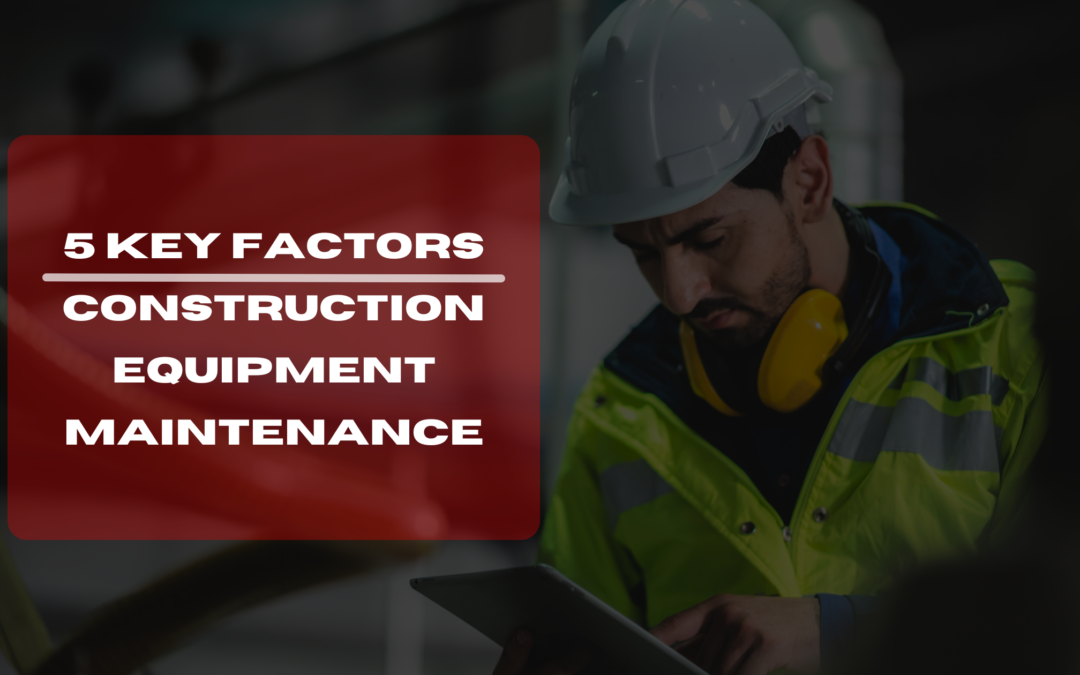Key factors to consider for Construction Equipment Maintenance
In the world of construction, equipment is the lifeblood of projects. From towering skyscrapers to intricate roadwork, the reliable operation of construction equipment is essential. Yet, every piece of machinery, no matter how robust, requires care and attention to keep it running smoothly. This brings us to the vital topic of evaluating the maintenance needs of construction equipment.
Table of Contents
Unveiling the Essentials
Understanding the factors that influence maintenance decisions in construction is akin to mastering the art of preserving your project’s lifeline. Here, we unveil the key factors that should never be overlooked:
Factor 1: Usage Patterns
- Why it matters: The frequency and intensity of equipment use play a pivotal role in determining maintenance needs. Equipment subjected to continuous operation or heavy-duty tasks may require more frequent maintenance checks.
- Takeaway: Regularly assess usage patterns to tailor maintenance schedules accordingly, optimizing equipment performance and longevity.
Factor 2: Environmental Conditions
- Why it matters: Where equipment operates matters as much as how often it’s used. Harsh environments, such as extreme temperatures or exposure to corrosive substances, can accelerate wear and tear.
- Takeaway: Prioritize maintenance routines that consider the specific environmental challenges equipment faces, ensuring its resilience.
Factor 3: Manufacturer Recommendations
- Why it matters: Equipment manufacturers provide detailed guidelines for maintenance schedules and procedures. Ignoring these recommendations can not only void warranties but also compromise equipment performance.
- Takeaway: Always adhere to manufacturer recommendations to ensure proper care and operation of your equipment.
Factor 4: Age and Equipment History
- Why it matters: Older equipment may have different maintenance needs compared to newer counterparts. Reviewing equipment history can reveal recurring issues and areas of concern.
- Takeaway: Tailor maintenance plans based on equipment age and historical performance, addressing potential problem areas proactively.
Factor 5: Workload Variation
- Why it matters: Equipment subjected to varying workloads may experience different wear patterns. Understanding workload fluctuations helps in planning maintenance effectively.
- Takeaway: Consider workload variations when scheduling maintenance to align with the equipment’s actual usage.
“Preventive maintenance is the key to reliability.” – Christie Comstock
This quote by Christie Comstock underscores the importance of proactive maintenance in construction equipment. Preventive maintenance, guided by a deep understanding of the factors mentioned above, is indeed the key to ensuring reliability on the job site.
Maximizing Equipment Lifespan
Proactive maintenance isn’t just about fixing issues; it’s about preventing them in the first place. By addressing maintenance needs promptly, you can significantly extend the lifespan of your construction equipment. This not only protects your investment but also reduces the need for premature replacements.
Minimizing Downtime
Construction projects are all about schedules and deadlines. Unexpected equipment breakdowns can be catastrophic, leading to costly delays. Regular maintenance reduces the risk of sudden failures, minimizing downtime and keeping your project on track.
Safety Assurance
Safety is paramount in construction. Neglecting equipment maintenance can lead to accidents and injuries. Proper maintenance ensures that equipment operates safely, protecting your workers and your project’s reputation.
Cost Efficiency
While maintenance comes with a cost, it’s a small price to pay compared to the expenses associated with major repairs or equipment replacement. Proactive maintenance is cost-efficient in the long run, preventing expensive breakdowns.
Conclusion
Construction equipment is the backbone of any project, and its reliable operation is essential for success. Understanding the key factors that influence maintenance needs is a critical aspect of construction project management. By considering usage patterns, environmental conditions, manufacturer recommendations, equipment age, and workload variations, you can tailor maintenance plans that ensure equipment reliability, safety, and cost efficiency.
Remember, preventive maintenance is not just a choice; it’s a necessity. It’s the key to keeping your construction projects running smoothly, on time, and within budget. As Christie Comstock wisely said, “Preventive maintenance is the key to reliability.” So, embrace these key factors, and you’ll master the art of construction equipment maintenance like a true professional.
In the ever-evolving world of construction, knowledge is power, and maintaining that knowledge ensures the power keeps flowing.
Discover more about construction project management and equipment planning in our series of informative articles.

